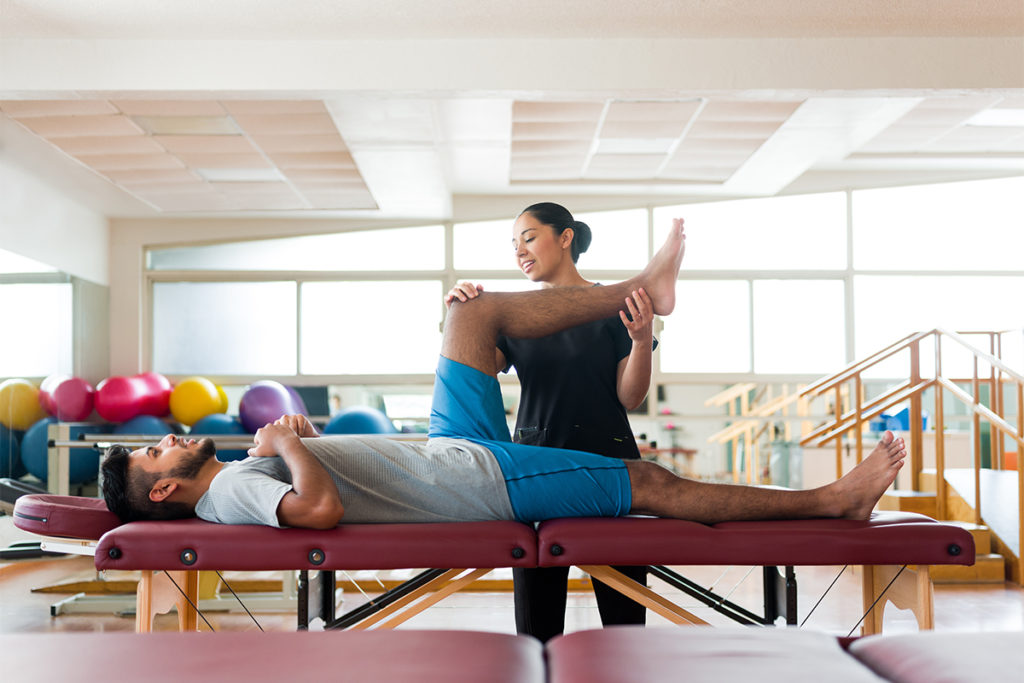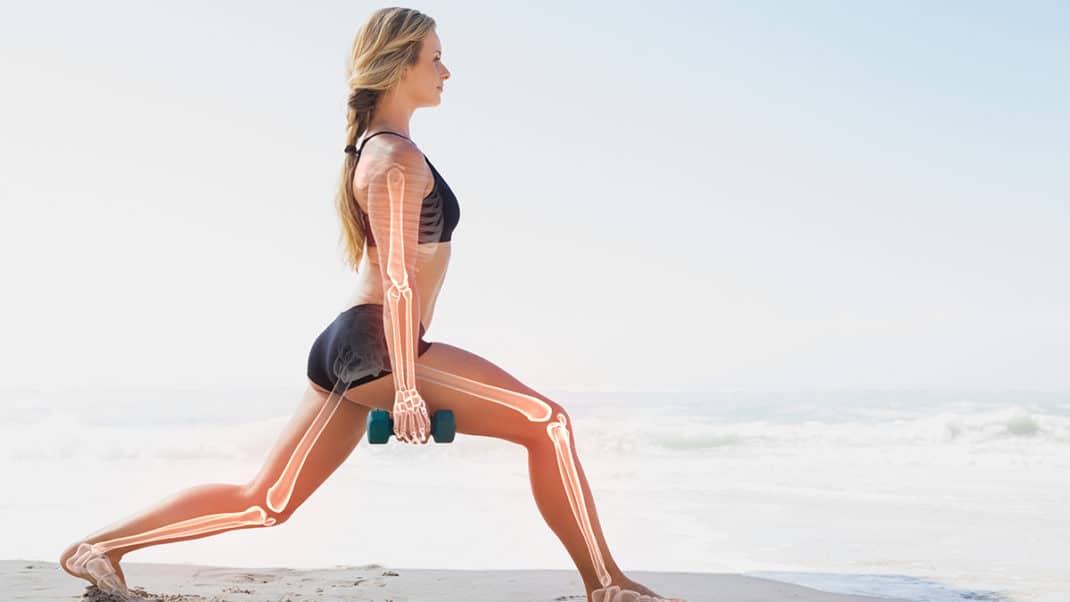Excessive Thoracic Kyphosis: Much More Than Just Bad Posture
Stress, environment and many exercises can contribute to a hunched-over effect.

Excessive thoracic kyphosis is a disproportionate forward rounding or curvature of the middle and upper back, also known as the thoracic spine (Kendall, McCreary & Provance 2005). ETK is an extremely common musculoskeletal imbalance brought on by prolonged time in some postural positions; exercise and/or activity choices; environmental factors; myofascial dysfunction; intolerances to food and/or other allergic reactions; and psychological stress.
Symptoms of ETK include musculoskeletal aches and pains, breathing problems, limited function, impaired athletic performance, gastrointestinal upsets and increased mental stress (Rolf 1989; Myers 2001; Hanna 1988; Price 2010). This article shows you how to identify ETK, highlights some of its common causes, discusses potential symptoms and provides ways to address the problem.
Excessive thoracic kyphosis is inherently linked to rib cage function because each rib attaches to a vertebra of the thoracic spine. The following musculoskeletal assessment can show whether you or your clients have ETK.
Place the index finger of one hand on the sternal notch, the indentation between your collarbones at front of your throat. Then place the index finger of your other hand on the vertebrae immediately below the ones that stick out most at the base of your neck. Turn your head to the side and look at the position of your fingers in a mirror. Ideally, your fingers should be at approximately the same height. If the finger on the front of your chest is lower than the finger on the back of your neck, your thoracic spine has rounded forward and your rib cage has dropped, meaning you have ETK.
The most common causes of ETK include the following:
- musculoskeletal compensations
- environmental factors
- exercise/activity choices
- psychological stressors
Musculoskeletal imbalances anywhere in the body can cause ETK. For example, moving the head forward of its optimal position to focus on a small object like a handheld electronic device causes the thoracic spine to round forward in order to help hold up the head (Kendall, McCreary & Provance 2005). This is akin to having a large fish on the end of a flexible fishing rod. The rod will bend forward to accommodate the extra weight. Over time, this forward head position can lead to ETK.
ETK can also result from habitual overpronation, where the feet collapse excessively. When the feet collapse inward, the ankles roll in and the legs rotate toward the midline of the body. This internal rotation of the legs causes the hip sockets to shift backwards and the pelvis to rotate forward. This rotation of the pelvis causes the lower back to overarch (excessive lumbar lordosis) and the middle and upper back to round forward so that the body stays balanced (Price 2010).
Myofascial adaptations and restrictions can likewise lead to ETK. For example, changes in the length-tension properties of the biceps muscle, which originates on the outside edge of the scapula and attaches to the forearm, can contribute directly to this imbalance. When the arms are flexed for prolonged periods during activities like cooking, driving and typing, the biceps muscles become chronically shortened. When the arms are subsequently straightened, these muscles cannot lengthen properly. This causes the forearms to pull the shoulder blades forward (via the biceps) on the rib cage. This forward position of the shoulder blades ultimately results in the rib cage dropping forward, causing thoracic kyphosis (Myers 2001).
Excessive rounding of the upper back is commonly associated with sedentary lifestyles or occupations that involve lengthy periods of sitting, such as video gaming or computer-based desk jobs. However, some less-obvious environmental stresses can also lead to ETK. Respiratory conditions like asthma, COPD and allergies to air pollutants can affect the body’s breathing mechanisms and the diaphragm’s ability to contract and relax correctly. Rib cage restrictions caused by chronic breathing problems can result in immobility of the thoracic spine and can eventually cause ETK (Rolf 1989).
Food sensitivities are another trigger for excessive thoracic kyphosis. Gluten, lactose, fructose and alcohol intolerances can inflame our digestive tract (Harker 1998). The gut shares connective tissue with other soft-tissue structures and muscles that attach to the spine. As such, chronic inflammation of the gut can cause myofascial restrictions and adhesions throughout the torso, causing ETK.
Exercise and activity choices can also contribute to ETK. Prolonged periods of spine flexion, as required for bike riding and/or indoor cycling, martial arts, freestyle swimming and hobbies like knitting and gardening, are major factors in excessive thoracic kyphosis.
When the brain perceives a threat, whether real or imagined, the body physically prepares to act against the danger—the flight-or-fight response. Typical reactions include tensing the jaw, tightening the abdominals, holding one’s breath and rounding the shoulders (Hanna 1988). Consequently, ongoing psychological stressors—such as career dissatisfaction, relationship troubles, money problems or family issues—can bring about fascial restrictions, neuromuscular adaptations and musculoskeletal changes in the body that result in ETK.
ETK is essentially a postural problem, but it can also manifest as a variety of other symptoms:
- pain
- limited function
- poor health and disease
- increased mental stress
ETK is usually accompanied by excessive lumbar lordosis, an overarching of the lower back that can lead to lower-back pain, disk degeneration and nerve compression (McGill 2002). It can also cause excessive cervical lordosis, an overarching of the neck that counterbalances the forward head position and can lead to tension headaches, jaw pain and/or neck and shoulder pain. ETK can contribute to pain in the lower extremities as well.
Previously described compensatory movement patterns that occur as a result of ETK (forward head, lumbar lordosis, overpronation and so on) can spawn problems like sciatica, sacroiliac joint pain, hip bursitis, IT band syndrome, knee pain, Achilles tendinitis, plantar fasciitis and ankle pain (Kendall, McCreary & Provance 2005; McGill 2002; Price 2010 ).
Everyday movements and athletic performance can be limited by ETK. The excessive flexion of the middle and upper back characteristic of ETK limits shoulder function, which can make it difficult to do things like raising your arms to wash your hair, putting dishes in an overhead cupboard or pulling on a sweatshirt. ETK can also affect motions that require thoracic extension, such as the butterfly stroke in swimming and the upward-facing-dog pose in yoga.
ETK is a protective posture that restricts movement of the torso. As discussed earlier, ETK can affect respiration, which in turn can restrict blood supply to internal organs. The downward movement of the diaphragm as it contracts helps massage the liver and bring blood supply to other vital organs. Hence, ETK’s tendency to disrupt respiration can enable a host of intestinal problems and/or diseases (Rolf 1989).
When the body assumes an excessive thoracic kyphotic posture, the nervous system interprets it as a threat and activates the parts of the brain that process stress. Over time, this increased activity in the “stress areas” of the brain causes fatigue, rendering the body (and brain) unable to cope effectively with stress (Lawlis 2008).
Several strategies can alleviate ETK:
- corrective exercises
- dietary changes
- breathing practice
- relaxation
- life coaching
Self myofascial release techniques are very effective for decreasing restrictions in the fascia and for improving posture.
Two Tennis Balls on Upper Back
Tennis balls and a pillow are all you need in this strategy to address ETK.
This self-massage technique promotes extension in the thoracic spine.
Lie on the floor on your back with knees bent. Place a tennis ball on either side of your spine in line with the bottom of your shoulder blades. Use a large pillow to support your head so you don’t feel too much pressure from the tennis balls. Bring your arms across your chest and hug yourself. Find a sore spot and maintain pressure on it until it releases (10–15 seconds). Then move the balls to another sore spot by scooting your butt and body down so the balls roll up your spine. Bring the pillow with you each time you scoot. Spend about 2–3 minutes each day on the entire area.
Tennis Ball on Abdominals
This technique uses a single tennis ball under the abdomen.
This self-massage technique releases tension in the abdominals and hip flexor muscles/fascia to help promote trunk mobility and thoracic spine extension.
Lie on the floor face down. Place a tennis ball on your stomach just below the bottom of your rib cage to the right of your bellybutton. Find a sore spot and maintain pressure on it until it releases (5–10 seconds). Then move to the next spot by scooting your body up so the ball moves down. Do this all along your abdomen, past your bellybutton to the top of your hips. Repeat the process on the left side. Do each side for about 1–2 minutes.
People susceptible to inflammatory foods such as gluten, wheat, lactose, sugar and alcohol should limit the intake of these foods and beverages. Increasing the intake of various anti-inflammatory and/or soothing foods/compounds such as aloe vera, slippery elm and yogurt or other probiotics can improve the health of the gastrointestinal tract and consequently can alleviate ETK.
Diaphragmatic breathing techniques help mobilize the ribcage, strengthen the diaphragm, supply blood to the organs, promote relaxation and decrease stress.
Lower Rib Expansion
Hands should be placed palm-down around the bottom of the rib cage.
Lie on your back with your knees bent (support your head with a small pillow, if necessary). Place your hands palm-down around the bottom of your rib cage. Practice breathing in and out through your nose. As you breathe in, focus on the lower ribs expanding and pushing into the palms of your hands. Hold the breath (a diaphragmatic contraction) for a few seconds and then slowly breathe out. Do a total of 10–15 breaths every day.
In addition to causing ETK, mental stress can manifest as muscular pain, breathing problems, dizziness, headaches, gastrointestinal issues and skin problems like hives, eczema and rashes. These symptoms can be red flags for situations that have become detrimentally stressful. Over the period of a week, make a note of each physical manifestation resulting from stress and when each of these issues becomes inflamed or problematic. Also note what you were thinking about or doing when the symptom became more noticeable; for example, “back pain worsening while thinking about a recent argument” or “headache coming on after dealing with a trying client.” Once you become aware of your stress triggers, concentrate on limiting your exposure to these types of situations.
Our musculoskeletal and neuromuscular systems are designed to respond to ever-changing environments. The key to keeping ETK at bay is to pay attention to symptoms like musculoskeletal pain, mental stress, gastrointestinal distress and subpar performance, which all point to an overload or imbalance in your physical and mental environment. Strategies like those outlined above can moderate the impact of your lifestyle and activities, helping you avoid the potentially harmful effects of ETK.
One finger points to the sternal notch and the other points to the vertebrae just below the ones that stick out most at the base of the neck. If the finger in the back is higher than the one in front, this indicates ETK.
References
Justin Price, MA
Justin Price, MA, is creator of the BioMechanics Method® Corrective Exercise Specialist (TBMM-CES) program, the fitness industry’s highest-rated CES credential, with trained professionals in 80 countries. He is also the author of several books, including The BioMechanics Method for Corrective Exercise academic textbook, and he was awarded the 2006 IDEA Personal Trainer of the Year. He has served as a subject matter expert for numerous brands and media organizations including ACE, TRX® and BOSU®; the BBC, Discovery Health and MSNBC; Arthritis Today, Men’s Health, Newsweek, Time, WebMD and Tennis; and Los Angeles Times, The New York Times and Wall Street Journal. Learn more about The BioMechanics Method®








